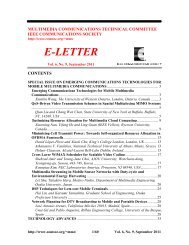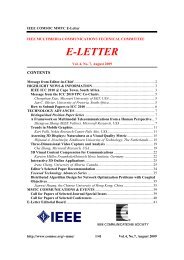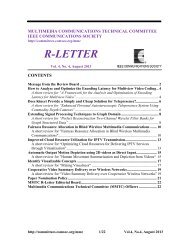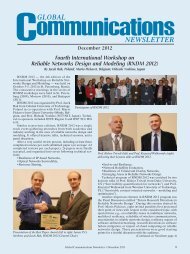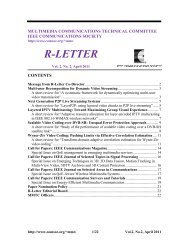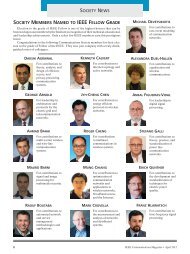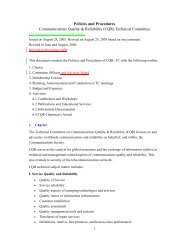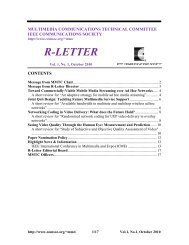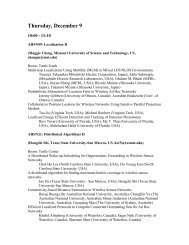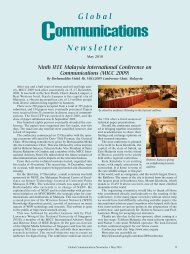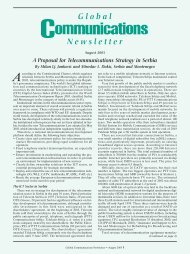PRISM - vol. 1, no. 3 - IEEE Communications Society
PRISM - vol. 1, no. 3 - IEEE Communications Society
PRISM - vol. 1, no. 3 - IEEE Communications Society
Create successful ePaper yourself
Turn your PDF publications into a flip-book with our unique Google optimized e-Paper software.
of a frame, to ensure that it arrives on the port from the source SPT, and this allows relaxation of loop prevention for<br />
unicast traffic.<br />
SPB takes advantage of the auto discovery mechanisms built into IS-IS, extending this to include service<br />
membership discovery. For this, the VIDs or PBB Service Identifiers (I-SIDs) configured on SPT Bridges are<br />
carried in ISIS-SPB TLVs. Thus, ISIS-SPB can configure frame forwarding specific to the registered services<br />
without extra discovery mechanisms. This in<strong>no</strong>vation eliminates the need for signaling, and the delays associated<br />
with sequential hop-by-hop messaging,<br />
SPB has two operating modes, distinguished by the applied SPT identification. Shortest Path Bridging VID<br />
(SPBV) uses a VID per bridge to identify each SPT, and this collective set of SPVIDs supports a VLAN. Within<br />
that VLAN, conventional “reverse path learning” is used to optimize unicast forwarding. A distinguished VID, the<br />
Base VID, is used to identify the VLAN in management operations in SPBV, and in Shortest Path Bridging MAC<br />
(SPBM) mode too.<br />
In contrast a Backbone MAC address is used as the identifier of an SPT in SPBM, which uses the 802.1ah<br />
encapsulation. The resultant scalability makes it appropriate for larger fully managed networks. SPBM is used in a<br />
PBB network where all the B-MAC addresses are managed, and so MAC address learning from data frames is<br />
turned off. Otherwise, both modes operate along the same SPB principles and network can support either mode or<br />
both simultaneously since they are separated by Base VID. The operation of SPB will be described more in detail in<br />
[7] and other publications in addition to the standard.<br />
Use of Equal Cost Paths<br />
Shortest path forwarding results in better utilization of a mesh network. Even greater utilization can be obtained by<br />
the spreading of offered load across multiple diverse equal cost shortest paths. 802.1aq achieves this via<br />
manipulation of the criteria for selecting between equal cost paths and leveraging the ability of the Ethernet data<br />
plane to instantiate different path permutations in different VIDs. This is particularly important for Campus and<br />
Data Centre applications, where requirements for capacity and robustness are achieved by spreading load over a<br />
broad, massively connected, hierarchy of switches, exemplified by the “Fat Tree” structure.<br />
When presented with equal cost paths, the SPB congruency properties can only be achieved when all bridges<br />
make the same path choices for each path permutation, requiring independence of the computation order, and of the<br />
network position of the computation. Each bridge has a Bridge ID, which ensures uniqueness. A PATHID is<br />
specified as the lexicographically sorted list of the Bridge IDs which the path traverses. Thus, all <strong>no</strong>des<br />
implementing the same logic choose the same path from the multiple options (for example the one having the lowest<br />
PATHID). By using a set of globally defined transformations of the Bridge ID prior to sorting, different paths are<br />
selected. Since Priority is numerically the most significant part of the Bridge ID, the masking of bridge priority<br />
results in a different sort order when different priorities are used. 802.1aq specifies 16 Bridge ID priority transforms<br />
and makes possible the application of further tie breaking methods to choose from the nearly infinite set of other<br />
possible permutations.<br />
The initial 16 equal cost trees have unique properties. Firstly, the path congruence property means that 802.1aq<br />
actually supports equal cost routing for multicast and broadcast traffic. Secondly, since assignment of traffic to a<br />
path is done at the ingress to the 802.1aq network, the operator has the ability to forgo random assignment and place<br />
the traffic based on estimates of utilization, which can be considered a very lightweight form of traffic engineering.<br />
For example, all traffic, both unicast and multicast, for one subnet in a Data Center can be constrained to one set of<br />
shortest paths, while traffic for a different subnet can be constrained to a second.<br />
ONTC Newsletter, “Prism” Vol. 1. No. 3. August 2010



